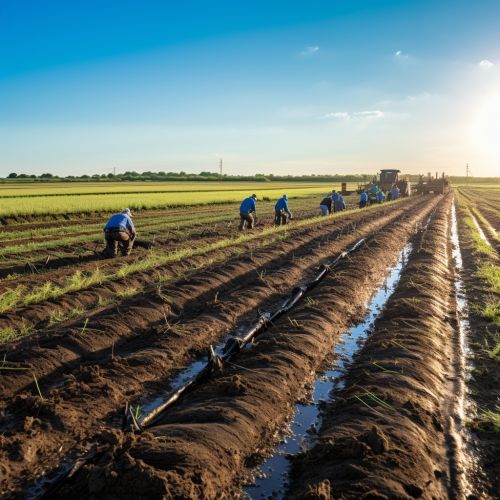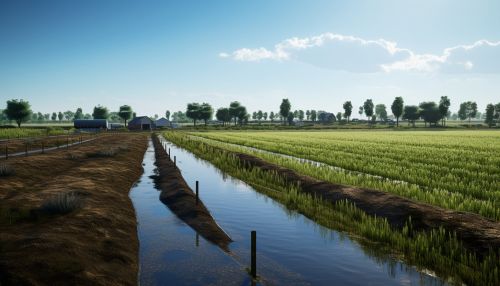Subsurface drainage
Overview
Subsurface drainage refers to the process of removing excess water from the soil below its surface. This is typically achieved through the use of a system of pipes, drains, and other infrastructure that allows water to flow away from the area. The primary goal of subsurface drainage is to improve the conditions of an area for agricultural, residential, or other uses. Agricultural and civil engineering practices often involve subsurface drainage to prevent waterlogging and to maintain soil health.
History
The concept of subsurface drainage has been around for centuries, with early examples found in ancient civilizations such as the Indus Valley and Rome. These societies recognized the need to control water levels in the soil to improve crop yields and prevent structural damage to buildings.
Principles of Subsurface Drainage
Subsurface drainage works on the principle of removing excess water from the soil strata below the surface. This is achieved by installing a network of pipes or drains below the ground that collects and redirects the water away from the area. The effectiveness of a subsurface drainage system depends on several factors, including the permeability of the soil, the depth and spacing of the drains, and the gradient of the land.
Types of Subsurface Drainage Systems
There are several types of subsurface drainage systems, each with its own advantages and disadvantages. These include:
- Pipe Drainage Systems: These involve the use of perforated pipes buried in the ground to collect and carry away excess water. The pipes are typically made of plastic or clay and are laid in a pattern that ensures optimal coverage of the area.
- Mole Drainage Systems: This type of system involves creating channels in the soil using a special plough known as a mole plough. The channels allow excess water to flow away from the area. Mole drainage systems are often used in conjunction with pipe drainage systems, particularly in heavy clay soils.
- French Drains: A French drain is a trench filled with gravel or rock that contains a perforated pipe. The trench provides a path for water to flow away from the area, and the pipe helps to collect and direct the water.
- Tile Drainage Systems: These are similar to pipe drainage systems, but use tiles instead of pipes. The tiles are typically made of clay or concrete and are laid in a pattern that ensures optimal coverage of the area.


Design and Installation
The design and installation of a subsurface drainage system require careful planning and execution. Factors to consider include the type of soil, the topography of the land, the intended use of the area, and local environmental regulations. The process typically involves surveying the land, designing the drainage system, excavating the area, installing the drains, and backfilling the trenches.
Maintenance and Management
Proper maintenance and management of a subsurface drainage system are crucial to its effectiveness. This includes regular inspections to check for blockages or damage, cleaning of the drains as needed, and monitoring of the system's performance. In some cases, additional measures may be necessary, such as the use of chemical treatments to prevent the growth of algae or other organisms that can clog the drains.
Environmental Impact
While subsurface drainage can have significant benefits, it can also have environmental impacts. These include changes to the water table, loss of wetland habitats, and the potential for contamination of water bodies with nutrients or pesticides from agricultural runoff. Therefore, careful design and management of subsurface drainage systems are essential to minimize these impacts.
